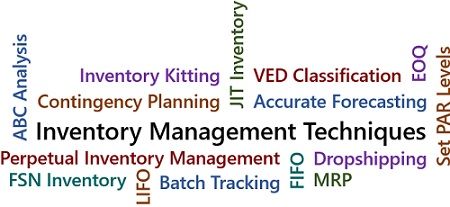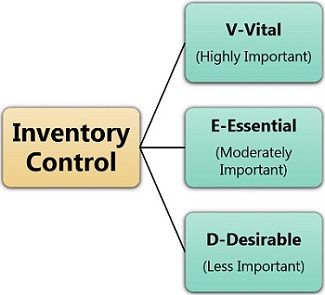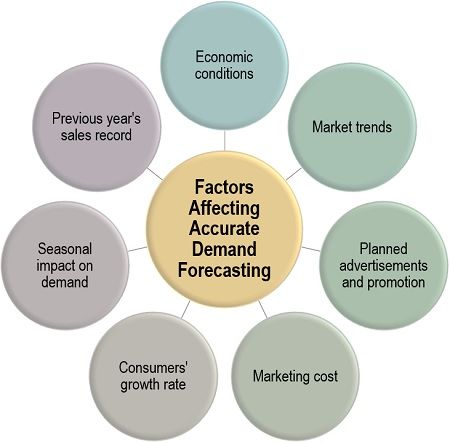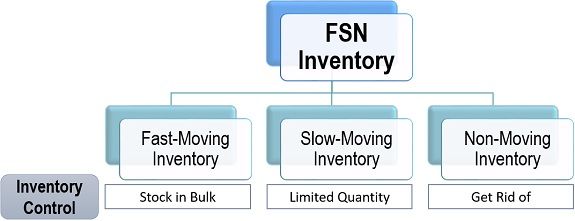Definition: Inventory management techniques can be seen as a useful tool in the hands of the management. It ensures the availability of the right type of stock, at the right time, at the right place and in the desired quantity. It also enables the managers to match the inventory shown in the books of accounts with that available.
Example: A garment manufacturing industry found that in the financial year 2018-19, it ha increased its sales by 33%. However, the Cash Flow statement depicted a very low balance, indicating that the company lacks sufficient operating capital.
On analyzing the books of accounts, it was found that the company has blocked its working capital in the excess inventory.
The stock was maintained in a vast quantity taking up the warehouse space, demanding high maintenance cost and some of the stock even became obsolete.
All this is the result of substandard and unplanned inventory management.
Content: Inventory Management Techniques
Different Techniques of Inventory Management
Before starting with the explanation of each of these methods; please note that there is no perfect way of inventory management. Instead, an organization can go for one or more techniques to plan, manage and optimize its inventory.
Now, let’s move on to the detailed description of various inventory management techniques:
First-In, First-Out (FIFO)
First in, first out is the most prominent inventory valuation method for managing the perishable goods. These include flowers, fruits, vegetables, fish and meat products, dairy items, chemicals and pharmaceuticals.
FIFO states that the goods which were received first (old stock) needs to be consumed initially. Thus, reducing the spoilage of those goods which have a short shelf life.
For this purpose, the store in-charge must ensure proper arrangement of stock. It should be such that the newest batches should be placed in the last shelves, whereas the oldest ones should be kept in front.
One of the ways of organizing the goods is through their batch numbers or expiry dates.
In reselling businesses, this method also optimizes the inventory for non-perishable items that have occupied the store space, since a long time.
When the same product is ready to be launched with new features look, packaging or design; FIFO is used to avoid antiquity of the left out old stock.
Last-In, Last-Out (LIFO)
Last in last out is an inventory valuation technique used for the goods which are non-perishable and homogeneous. Some of these are bricks, cement, stones, sand, etc.
Since this type of stock is usually arranged in piles, the newest lot is on the top. Therefore, the most recent goods have to be used first, followed by the oldest stock, which is at the bottom.
Though, this technique shows a superior income statement; the balance sheet is poorly valued with old stock.
Also, the International Financing Reporting Standards (IFRS) and the Accounting Standards for Private Enterprises (ASPE) forbids the use of LIFO in accounting. In the US, Generally Accepted Accounting Principles (GAAP) has not imposed any such restrictions.
Economic Order Quantity (EOQ)
EOQ is used as an inventory management method to estimate the optimum quantity of material to be purchased. It is to fulfil the production requirement such that the inventory maintenance cost is minimal.
Following are the two main objectives of EOQ:
Reducing the total inventory cost is the primary aim of this method. These costs involve order cost, holding expense and shortage cost.
Next, is assuring that the right quantity of goods is ordered in each batch. It will not only reduce the frequency of order placement; but will also keep a check over the surplus inventory.
The formula of EOQ for inventory management is:
Where:
Q is the optimum order units;
D is the periodic demand (in units);
S is the cost of each purchase order;
H is the per-unit annual holding cost.
Later on, Baumol’s EOQ model was developed as a cash management technique for maintaining the optimum level of cash in the business.
ABC Analysis
Another inventory control method is ABC analysis that lists out the goods under three classes as follows:
- A, i.e., Highly Important: These are the goods which cost high and therefore, maintained in small quantity.
- B, i.e., Moderately Important: It constitutes the inventory which has an average value maintained in fair quantity.
- C, i.e., Less Important: These goods are available in huge quantity due to their low value or cost.
Thus, category A being quite expensive, requires constant monitoring through EOQ, periodic check on available quantity, inventory budgeting and ratio analysis.
The goods under category B should be ordered as per the market or production requirements.
Moreover, the ones that belong to category C does not require much control. Instead, only the cost monitoring approach is enough for such goods.
Vital, Essential and Desirable (VED) Classification
The VED classification is mostly used in industries where machines are used for production. It distinguishes the stock according to the significance of its usage into the following three categories:
- Vital: Items signifying the lifeline of the production process are termed as vital items. In the absence of these, the whole process would halt.
- Essential: The stockout cost of the essential items is quite high. Thus, their absence leads to a significant loss.
- Desirable: The desirable items does not immediately hamper the production and also have a minimal stock out the cost.
In the above classification, we can see that the essential items hold the highest significance since its non-availability would pause the production process. These items usually comprise of machinery which requires excessive control.
Dropshipping
Dropshipping is that form of business which ensures inventory control for resellers. The organization does not maintain any inventory.
On receiving the order from a customer, the company forwards it to manufacturer, supplier or wholesaler. Then, the vendor directly ships the product to the customer.
Thus, cross-docking has the following advantages:
- Minimal inventory cost;
- Meagre startup investment;
- Scalability with low risk;
- Minimal order fulfilment expense.
Contingency Planning
Contingency strategy can be seen as a backup plan. Thus, this type of inventory management technique helps to deal with any of the following adverse business circumstances:
- Shortage of space in warehouses;
- False inventory valuation or calculation;
- Vendor runs out of stock and cannot meet the order deadlines;
- A sudden increase in demand leads to stock over-valuation;
- The manufacturer or vendor stops dealing in particular goods without any prior information;
- The company runs out of sufficient working capital to acquire essential products.
In this method, the organization should foresee the inventory-related risk and its impact. Accordingly, it should plan what actions are to be taken, if any of the above problems arise.
Along with this, a constant effort should be made to build strong public relations for long-term existence.
Therefore, contingency planning is essential for effective inventory management.
Accurate Forecasting
In inventory management, market demand analysis and estimation of sales, play a significant role. If the organization lacks proper information about a precise number of future sales units, there are high chances of stock wastage or shortage.
While accurate demand forecasting the organization must look into the following factors:
- Economic conditions;
- Market trends;
- Planned advertisements and promotion;
- Marketing cost;
- Consumers’ growth rate;
- Seasonal impact on demand;
- Previous year’s sales record.
Set PAR Levels
Minimum safety stock or Periodic Automatic Replenishment (PAR) level refers to establishing minimum stock criteria for each type of goods. If the inventory goes down the set limit, it is an indication that the new minimum order needs to be placed.
For such decision making, the store manager needs to analyze the frequency of sales or production and procurement period. With the changing market demand, production capacity, warehousing capacity, maintenance cost and various other factors; the PAR levels can be altered.
Therefore, the organization must review the PAR levels considering these factors, from time to time. In the absence of the manager, safety stock levels also aid the employees to take prompt inventory procurement decisions.
Inventory Kitting
Product bundling as we call it is a method of creating a bundle by grouping different products, packaging and merchandising them together as a single unit.
In the inventory management, on selling a bundle, the system automatically associates the pack’s sale to the sale of items included in it, separately.
Some of the benefits of this method are as follows:
- Spontaneous selling of different products helps to minimize inventory obsoletion; along with clearance of the old stock.
- It reduces the overall warehousing, maintenance and shipping costs.
- It initiates inventory tracking and its minimum level maintenance.
- It improves the average order values and enhances sales revenue.
Just-In-Time (JIT) Inventory Management
Just-in-time is one of the Japanese inventory management techniques, that emphasizes keeping a ‘zero inventory‘.
As the name suggests, it refers to maintaining only that much stock which is required at present, for carrying out the production or merchandising process.
Some organizations first receive the order from the clients, and then they proceed with the inventory procurement and manufacturing activities.
Following are the various advantages of JIT:
- JIT benefits through ordering the new stock only when the old one is about to finish. Thus, it reduces obsoletion or expiry of the existing stock.
- It ensures a positive cash flow, with less working capital engaged in inventory.
- It also provides for optimizing the inventory cost by reducing the warehousing and insurance expenses.
However, one of the most significant drawbacks of this technique is it may result in stock-out. Since there is a possibility that the procurement team fails to order the goods on time or the delivery of stock is delayed.
Material Requirement Planning (MRP)
Commonly known as MRP method, it is an analytical approach. The manager places the order with the vendors, for new stock only after finding out the market demand and sales forecast, acquired from the different business areas.
For the manufacturers, merchandisers, wholesalers and stockists; it is a beneficial technique since it provides for price risk optimization and also reduces the overstock uncertainties.
Perpetual Inventory Management
It is a continuous inventory system that helps in regular tracking of the real-time stock movements.
In this method, the inventory is promptly updated in the books of accounts, as soon as the purchase or sale of goods is made.
Thus, this is a superior technique to the periodic inventory system which initiates only an occasional or random check of inventory through physical counting of goods.
Given below are the various plus points of perpetual inventory system:
- Efficient inventory forecasting;
- Immediate recording of the stock information;
- Competent in terms of time and cost;
- Error-free due to validated data.
Fast, Slow and Non-Moving (FSN) Inventory
The critical function of the FSN inventory technique is understanding the frequency with which a specific product is consumed for production or merchandising. Let us now go through its following three elements:
- Fast-Moving Inventory: The goods which are readily saleable or consumed in bulk, are termed as fast-moving inventory. The inventory turnover ratios of such stock are quite high.
- Slow-Moving Inventory: The stock which is not consumed that frequently resulting in low turnover ratio, is categorized under slow-moving inventory.
- Non-Moving Inventory: Some goods in the warehouse, goes out of demand and therefore, becomes obsolete. Many times, such non-moving inventory leads to dead stock.
The manager should take steps to use or eradicate the non-moving inventory for creating space in the warehouse. Also, the slow-moving goods should be stored in a limited quantity to avoid the chances of obsoletion.
On the other hand, the fast-moving stock should be maintained in a sufficient quantity for uninterrupted production or supply of goods.
Batch Tracking
Throughout the supply chain management, goods are recorded and traced as per their batch numbers, to facilitate lot tracking.
It is widely used to figure out where the inventory is, right from its receiving and warehousing to production or sales. It even keeps track of the products’ expiration date (if available).
Given below are the benefits of batch tracking to the organizations:
- Batch tracking is a more efficient method of inventory management when compared to the manual process.
- It improves vendor relationship through the identification and selection of prominent suppliers.
- It helps to make out defective products in a batch, and thus, reduces the chances of loss.
- A robust quality control system can be established through a lot tracking system. Since the expiry date of each product or batch is known, the chances of quality degradation reduce.
Conclusion
We have seen that managing inventory is a vital task for any business organization. In large scale companies, this process becomes even more complicated. Thus, automated ways of inventory management came into action for simplifying the entire process.
We have discussed the most common methods above. Other than these, there are multiple small techniques which also facilitate the inventory management process. Some of these include inventory turnover ratio, regular inventory audit, periodic inventory system, cycle counting, backordering, consignment, etc.
Leave a Reply